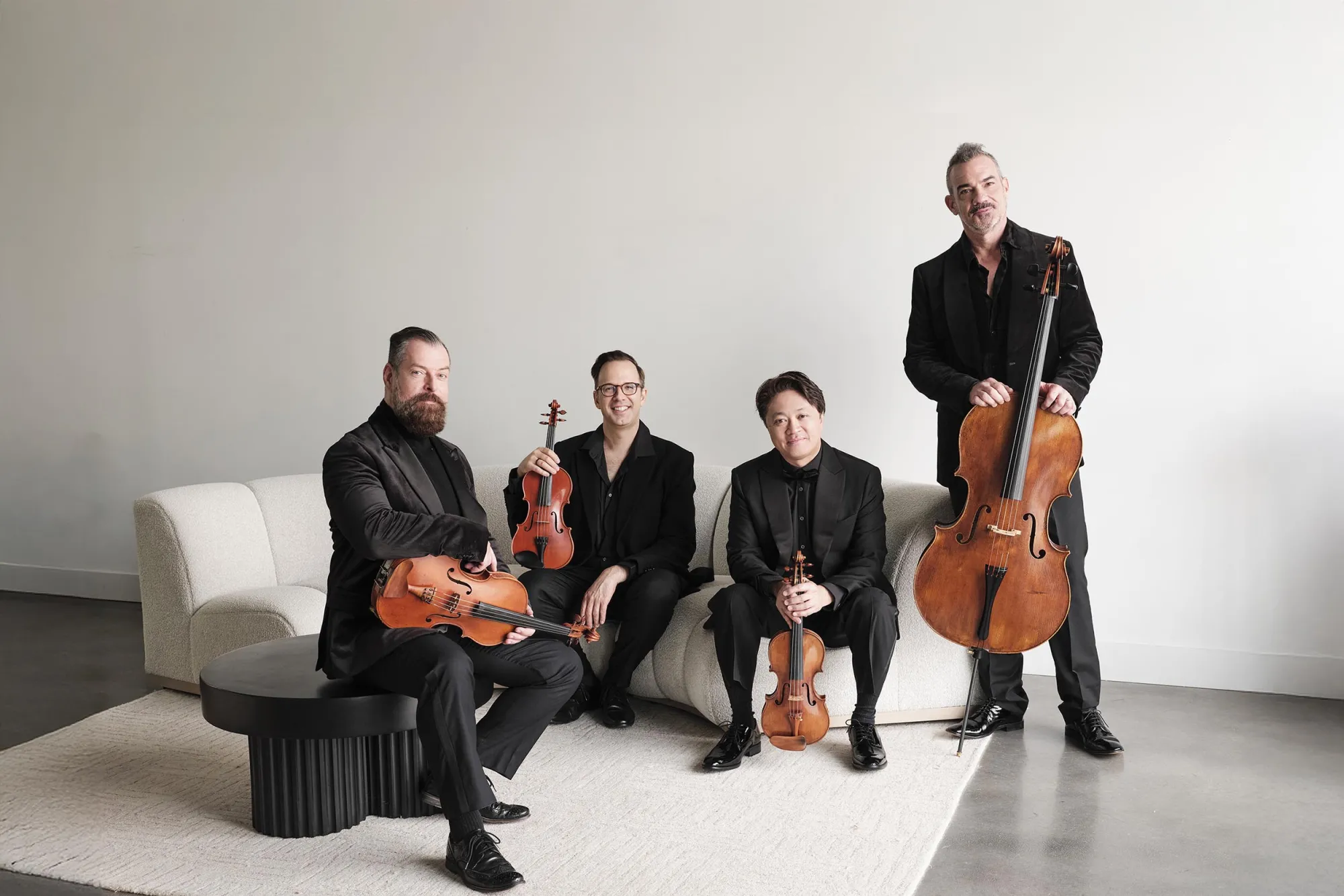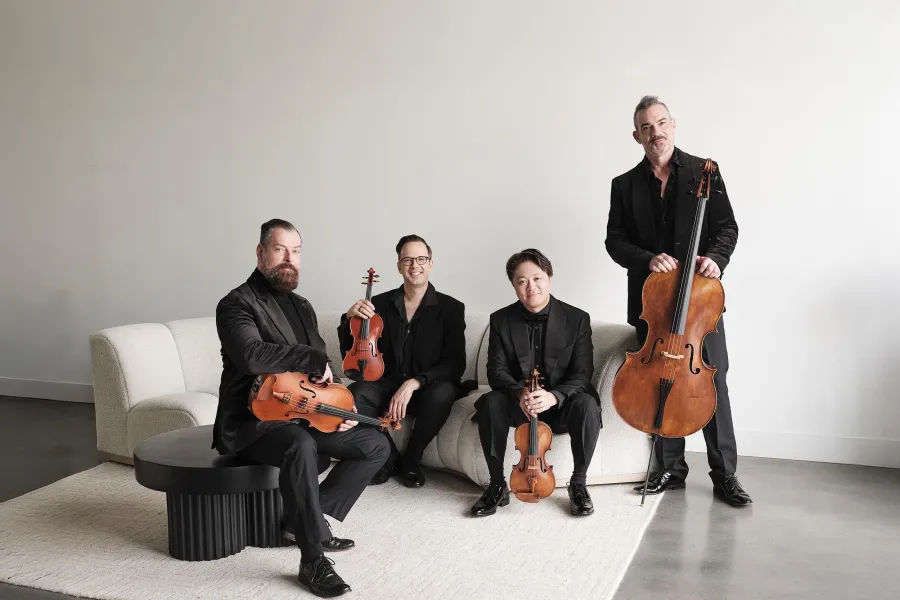Daniel Ching, violin
William Fedkenheuer, violin
John Largess, viola
Joshua Gindele, cello
This concert will last about 100 minutes with one intermission.
Please silence your electronic devices.
Photography, video, or recording of any part of this performance is prohibited
Program
Ludwig van Beethoven
String Quartet No. 12 in E-flat Major, op. 127
Maestoso—Allegro
Adagio ma non troppo e molto cantabile
Scherzo: Vivace
Finale: Allegro
intermission
Beethoven
String Quartet No. 13, op. 130
Adagio ma non troppo—Allegro
Presto
Poco scherzoso: Andante con moto ma non troppo
Alla Danza tedesca: Allegro assai
Cavatina: Adagio molto espressivo
Finale: Allegro
About the Program
Program notes by Penny Brandt
Ludwig van Beethoven
String Quartet No. 12 in E-Flat Major, Op. 127
Born December 17, 1770, Bonn, Electorate of Cologne, Holy Roman Empire
Died March 26, 1827, Vienna, Austrian Empire
Composed 1825
Premiered 1825
Duration 38 Minutes
In his twelfth string quartet, Beethoven sheds his characteristic heroic style in favor of a more intimate and lyrical exploration. The composer had long been interested in popular trends in philosophy, which, toward the end of his life, included Hindu and Brahman teachings. Whether the shift in his late style was influenced more by these ideas or by his increasing deafness, irritability, and loneliness, it remains that the E-flat Major quartet, Op. 127, features an affectionate and almost sacred quality that stands in stark contrast to the drama and struggle of the Eroica Symphony in the same key. The majestic introduction comes to rest on a sub-dominant harmony instead of the dominant, immediately thwarting our expectations of triumph with something more introspective. The main theme has a meditative quality that melts serenely into the second theme and development, and they meander together toward a tender end. The second movement is a set of variations on a prayerful theme. It is followed by a scherzo that provides a playful and energetic contrast to rest of the quartet. The finale explores the A-flat subdominant harmony that was touched in the introduction and presents a gentle, folk-like melody that makes its way to an expansive coda of tender transcendence
String Quartet No. 13, Op. 130
Composed 1826
Original Premiere March 1826, Vienna; Schuppanzigh Quartet
Duration 45 minutes
Toward the end of Beethoven's life, Prince Nikolai Borisovich Galitzine, an amateur cellist and ardent fan, commissioned the composer to write "two or three" string quartets in 1822. Beethoven fulfilled the commission by composing five quartets plus a bonus work, between 1824 and 1826, affectionately dubbed the "Late Quartets." The third, opus 130, is comprosied of six movements (instead of the more traditional four) and ended with a massive and broody Große Fuge (“Grande Fugue”) which upon its premiere proved to be difficult for both performers and listeners, and pushed the run-time of the quartet past the 1-hour mark. After this poor reception renewed rumors among the public about the composer's descent into madness, Beethoven's publisher eventually convinced him the fugue didn't work inside the quartet. After months of negotiaions, Beethoven agreed to composed a new final movement—a bright, cheery, and much shorter allegro—and spun the fugue out into its own work (opus 133). Completed late in 1826, the new final movement you'll hear tonight was the last piece the composer finished before his death in March 1827. The finished work is quintessentially Beethoven; themes re-appear again and again and are transformed and re-worked throughout. As with many of his late works, the quartet provoked a mix of reactions from listeners at the time. Many found it strange and difficult, while others heard it as intimate and transcendent. Beethoven juxtaposes slow, thoughtful meditations with light, jovial dances between and within movements. Mark Steinberg describes this quartet as an “Exquisite paradox: Music is inadequate to express what pleads to be expressed; this failure is flawlessly expressed by music.”
About the Artists
Miró Quartet

The Miró Quartet is one of America’s most celebrated and dedicated string quartets, having been labeled by The New Yorker as “furiously committed” and noted by the Cleveland Plain Dealer for its “exceptional tonal focus and interpretive intensity.” For over twenty-five years the Quartet has performed throughout the world on the most prestigious concert stages, earning accolades from critics and audiences alike. Based in Austin, TX, and thriving on the area’s storied music scene, the Miró takes pride in finding new ways to communicate with audiences of all backgrounds while cultivating the longstanding tradition of chamber music.
In their 2023-24 season, the Miró Quartet embarks on a new performance and recording project with pianist Lara Downes. Here on Earth features musical depictions of planet earth, its evolution, and the lives of its inhabitants, with works spanning a century of cultural shift that begins with Darius Milhaud’s La Création du Monde, performed in a new arrangement for piano and string quartet. Upcoming performances include the premiere of a new version of Kevin Puts’ Credo with the Naples Philharmonic, as well as performances for the Chamber Music Society of Lincoln Center, the Mondavi Center for the Performing Arts, the Saratoga Perfoming Arts Center, and Premiere Performances in Hong Kong.
Miró Quartet took its name and its inspiration from the Spanish artist Joan Miró, whose Surrealist works — with subject matter drawn from the realm of memory, dreams, and imaginative fantasy — are some of the most groundbreaking, influential, and admired of the 20th century.
Upcoming Events
Celebrating The Centennial Of Composer Robert Owens
Thursday, September 11, 7:30 p.m.
Bates Recital Hall
Free Admission
Tyler Webster, clarinet
Monday, September 15, 7:30 p.m.
Bates Recital Hall
Symphony Orchestra
Rebecca Davis, soprano
Friday, September 19, 7:30 p.m.
Bates Recital Hall
Schubertiade with Anton Nel & Friends
Monday, November 3, 7:30 p.m.
Bates Recital Hall
Miró Quartet
with Wilhelm Magner, viola
Friday, January 30, 7:30 p.m.
Bates Recital Hall
Event Details
$10 – 20
All University of Texas at Austin students are allowed one free ticket as long as they are available. Student tickets must be picked up at the Box Office with valid student I.D. Seating is unassigned.
If you are a patron with specific seating needs, please email tickets@mail.music.utexas.edu and we will reserve ADA seating for you.


